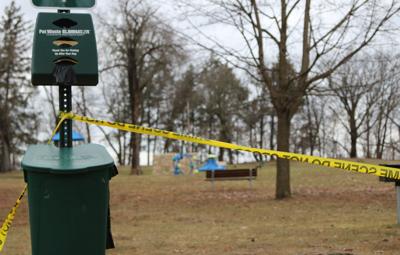Last Sunday, after searching all night for a 10-month-old baby who would soon be found dead inside a utility tunnel, police issued an Amber Alert.
At least they thought they did.
Instead, because of a technical glitch, the notice first went out at 10:10 a.m. only to local media and law enforcement agencies. The wider alert wouldn’t buzz the public’s phones until 11:15 a.m.
While the technology issue delayed the alert by about an hour, it’s fair to wonder whether the decision on Sunday morning to send out an Amber Alert already came hours too late.
No, I’m not suggesting a different, more merciful, outcome was likely in this case. But last weekend’s tardy issuance calls into question the purpose of the alerts and the leeway law enforcement officials are given to utilize them.
If used too often, Amber Alerts — designed primarily to provide notice of suspected child abductions – risk being compared to the boy who cried wolf.
But, on the other hand, members of law enforcement shouldn’t be hamstrung by strict activation criteria that slows the employment of a critical resource.
During a press conference this week, Schenectady Police Chief Eric Clifford described the timeline of last weekend’s tragedy, beginning with the call from General Electric security, just after 11 p.m. on Saturday, March 9.
When police interviewed Persia Nelson, 24, after finding her in a building on the GE campus that night, officers learned very quickly about her missing baby, according to Clifford.
“Unable to locate the child, they requested additional resources to assess where to expand their search,” Clifford said. “It took some time.”
It took some time.
Police had to invest time to track down where Nelson, who was mentally out of it and “didn’t know where she was,” according to Clifford, had entered the GE campus – and therefore where to focus their search.
At that point, the baby could very well have been alive. Found up to her chest in water about 8 feet down a pipe, the 10-month-old Halo Branton died of hypothermia, not drowning, according to Schenectady County District Attorney Robert Carney, who spoke at the same press conference as Clifford.
If the Amber Alert had been sent immediately after police knew of a missing baby, doesn’t it stand to reason they’d have possibly saved valuable time? Wasn’t there the off-chance that the same people who eventually helped police determine where to search would have seen the alert and made a call? The entire course of the investigation and search could have been altered.
Likely? No.
But maybe.
Come Sunday, hours after bringing in resources including dogs, drones, state officers and forest rangers to conduct a harrowing search in the rain and cold, police ultimately issued an Amber Alert.
“As the morning came, it was also decided that we could not rule out an abduction or the child being exposed to some other dangerous situation, so we decided to put out an Amber Alert,” Clifford said.

Schenectady chief of police Eric Clifford speaks to the media during a press conference at the Schenectady Police Department announcing new charges against Persia Nelson regarding the death of her daughter, 11-month old Halo Branton Monday, March 11, 2024.
So why the reluctance?
The public information officer for State Police Troop G, Trooper Stephanie O’Neil, explained via email that the state’s Amber Alert program requires reasonable belief by the investigating law-enforcement agency that an abduction occurred – rather than the case being a missing person. However, she noted “each case must be appraised on its own merits” and noted that other factors, such as a child’s age or pre-existing medical condition, could justify the alarm.
O’Neil said the strict criteria, based on the U.S. Department of Justice-recommended criteria, is to prevent Amber Alerts from being overused.
“Absence of significant information that an abduction has occurred could lead to abuse of the system and ultimately weaken its effectiveness,” O’Neil wrote.
There’s definitely logic to that point. If Amber Alerts were sent for every teenager who has run away from his or her parents, the system would cease to be useful.

A blanket and stuffed animals are placed on a stop sign at the corner of Campbell Avenue and 12th Street, where crime scene tape is attached and a Schenectady Police Department vehicle blocks the road adjacent to Hillhurst Park in Schenectady Monday.
But has this concern gone too far in the other direction? Have we given too much heft to strict activation criteria to the point where law enforcement have become too cautious?
A situation like a 1-year-old unaccounted for in the middle of the night warrants a widespread search. Law enforcement leaders should feel empowered to use every tool at their disposal – and use that tool expeditiously. If the explanation for a missing baby ends up being innocent, and the Amber Alert sent unnecessarily, the worst that happens is a collective sigh of relief.
Yes, there is surely a threshold at which people would stop paying attention to Amber Alerts. But we’re nowhere near that point. Last year, only four alerts were administered in all of New York state, and Sunday’s alert was the first of this year. In our region, only one was issued last year, and alerts only go to people within a specific geographical boundary.
We’d all be fine with several more phone buzzes and highway signs if it means having a greater chance at saving more kids.
After a 9-year-old girl went missing last year from Moreau Lake State Park, state police sent an amber alert — but they didn’t do so until the morning after the girl disappeared while riding her bike during a family camping trip.
Once the girl was found, people generally came away with renewed appreciation for the important mobilization that comes from Amber Alerts, even if the kidnapper’s own stupidity in leaving a ransom note with his fingerprint on it had more to do with finding the girl than the region-wide alarm.

Crime scene tape is wrapped around a tree at Hillhurst Park in Schenectady Sunday.
Following that case, State Assemblyman Angelo Santabarbara, of Rotterdam, introduced legislation to expedite the activation of Amber Alerts. The bill would, among other changes, give parents or legal guardians the ability to request state police issue an Amber Alert.
In last weekend’s case, the baby’s father could have theoretically made such a request if the law were on the books.
"The safety and well-being of our children are of utmost importance, and every available tool must be utilized to protect them,” Santabarbara said of his bill.
That’s absolutely right. When a child is missing and possibly in danger, we should harness every available option rather than fret and dither in deference to administrative hoops.
Think about the alternative.
In November 2022, 14-year-old Samantha Humphrey went missing in Schenectady. Chief Clifford told me last fall that an Amber Alert was considered when Humphrey went missing, but, ultimately, “the incident did not fit the criteria.”
Three months later, the teenager’s body was found in the Mohawk River beside the Stockade.
Would an Amber Alert have changed the outcome? Would an Amber Alert have saved Humphrey or Halo?
There is a glimmer of a chance, however faint.
And when we’re talking about tragic cases in which a girl is found dead in a river or a baby found in a pipe, we need to know we did all we could.
















